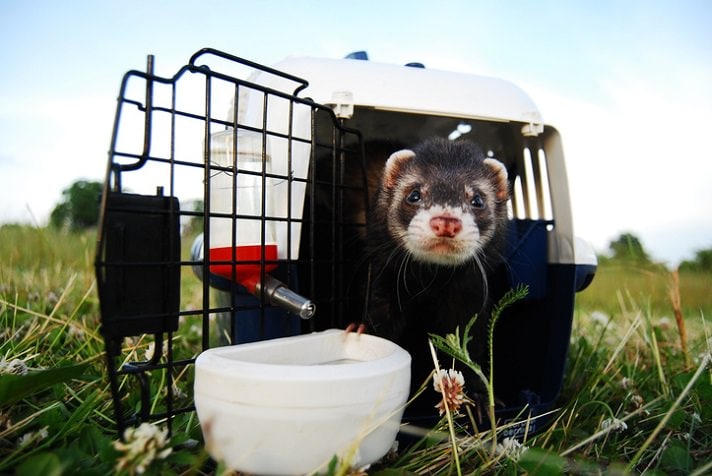Owning a ferret adds much more than just an adorable furball to your household. It also adds all the ferret supplies a polecat needs to be “at home” in your home. Think of it as having a friend move in with you — a small, furry friend!
New Ferret Supplies
The list of items that need to be ready and waiting for your ferret when it arrives at your home may seem daunting, but each serves a vital purpose.
1. Carrier
A small pet carrier, like the Kaytee Come Along carrier, is the safest way to transport your ferret in the car. Secure it with a seatbelt for the car ride and all will be well. This carrier is also needed for trips to the veterinarian, visits to friends, attendance at ferret fun events or wherever else you might travel with your ferret.
2. Cage
A cage goes a long way toward keeping your ferret safe. Ferret-proofing an entire house is virtually impossible. Unless you choose to create a single, ferret-proofed room where your pet runs free, an escape proof ferret cage is probably your best bet. A stainless steel or coated wire cage with a solid-surface bottom is a good choice. Get the largest one you can fit into your home (but no smaller than 36- by- 24 by- 24 inches high for a single ferret) that has bar spacing of not more than 1-inch square. A good option is a Prevue Pet Products cage. If a cage has a wire bottom or ramps, add linoleum or some solid surface to protect your ferret’s paws. Although the cage creates a safe area for your pet while you’re away, be aware that you must allow your ferret at least four hours of playtime outside the cage every day.
Ferrets also enjoy a safe place to hide and or sleep within their cage. This can be a small box inside your ferret’s cage which will provide it with a quiet, dark place to retreat for sleeping or whenever it might feel the need for privacy.
Ferrets are den animals and enjoy burrowing. To satisfy this behavior we like to provide several sleeping areas for your pet by hanging a hammock or two in the cage and providing one or two sleep sacks. Choose items with closely woven fabric and avoid any with loops that might catch on toenails, like the Marshall hanging sleep sack. Washable fabrics and ease of removal are musts for frequent washings. (Weekly cage cleaning and bedding washing greatly reduces any odor.)
Some people like to create a dig box to serve as a “Playground” for their pets. This can be made using a small storage container filled with clean dirt, cornstarch packing peanuts, long-grain rice or other ferret-safe (can’t be swallowed or inhaled) materials.
To allow your ferret time out of its cage and yet some containment a gate can be used. A ferret gate is any sort of barrier you might put in a doorway to keep a ferret in or out of a room. It needs to be impossible to climb, or get caught up in and high enough so a ferret can’t jump over it.
Any time you want to take your ferret to a nonferret-proofed area (another room in your house, outside, a friend’s home), a playpen will prove invaluable. This portable system of interlinking wire walls will keep your ferret safely confined.
3. Food
Ferrets are obligate carnivores with a short digestion time. To provide proper ferret care, food should be available to them at all times. So along with other ferret supplies, make sure to stock up on kibble before bringing your new friend home. The nutritional needs of ferrets differ from other pets, so choose a quality ferret-specific food. It is best to find a Veterinarian familiar with ferret care requirements. They would recommend a ferret specific diet that is high-protein (32 to 40 percent), high-fat (18 to 22 percent), and low-fiber diet (2 to 3 percent). The protein must be from an animal source. Always find out what your new ferret has been used to eating and continue feeding that. However if you wish to switch to another high quality food, do so gradually.
4. Food & Water Dishes
A ferret has to eat and a food bowl is the place to put its food. Ferrets might try to play with the bowl, so opt for one that’s too heavy to tip or attaches to the side of the cage, like the Kaytee small animal food bowl. Hydration is very important to overall ferret care health. Always have fresh, clean water available for your pet. Water in a bottle may stay cleaner, but a ferret may enjoy playing in a water bowl.Product: 104076
5. Toys
A ferret’s intelligence can cause it to become bored quickly. And a bored ferret can be mischievous or sink into depression. Provide several ferret-safe toys (no small parts that can be chewed off and eaten) inside the cage and out. Try the Marshall Pop N Play ball pit for fun. Rotate the toys available to keep them “new.”
6. Litter Box
If you’d rather make do with newspaper for litter control, you can. However, most ferret owners find that the litter box/litter method works well. A ferret-specific litter box brings the most success. Ferrets need a low entryway, but high back and sides, like the Ware Scatterless litter box, for example. If you have a litter box, you’re going to need litter to fill it! Some owners even choose to layer the bottom of the cage with it. When choosing litter, avoid those that clump, have excessive dust or emit odors or chemicals. The phenols in cedar and nonkiln-dried pine might negatively affect your ferret’s health. Although many things can be used to scoop litter, a litter-scooper may be specially designed to get into corners and make the job easier. The iPrimio non-stick scooper is a good option.
7. Veterinarian
No, you can’t buy a veterinarian and take him or her home! However, you do need to find a ferret-knowledgeable vet in your area. All ferrets should visit a veterinarian at least annually for a checkup, and rabies and canine distemper vaccinations. Your vet can educate you regarding proper flea/mite control product for your ferret.
Consult your veterinarian to determine which is best for your ferret. Your new ferret should visit the vet for a wellness checkup and review of its vaccination needs. Young ferrets need several vaccines and boosters.
Whew! That wasn’t so bad, was it? Now that you’ve got the basics down, here are a few other items you should get when you have the chance.
8. Hairball Remedy
Ferrets can’t cough up hairballs as cats do, so this treatment remedy helps hairballs “pass through.” Without it, you may end up facing a veterinary bill for surgery to remove a blockage. Follow directions and offer the remedy one or two times a week, or three or more times a week (shedding season [spring and fall] requires more frequent doses).
9. Collar
Some ferret owners put collars on their pets, some don’t. It’s up to you whether you’d like a collar with an identification tag or a bell to help you locate your pet. If your ferret ever escapes from your home, this could make the difference in whether you get it back.
If you want to take your ferret on walks or outings, a ferret specific harness & leash is recommended so that you have control, though it may take some time for your ferret to accept the restraint.
10. First-Aid Kit
Find one made for animals. One of the most important contents would be something to stop bleeding. In the event of any situation where your ferret’s health in questionable – it is critical to be able to contact a veterinarian that has experience in ferret care.
11. Nail Trimmer
Long ferret nails might scratch you, but they also get caught on fabric or other items. Save your pet from the pain of having a nail ripped out by trimming its nails regularly. Trimmers made for ferrets or cats work well.
12. Ferret Shampoo
Ferrets don’t need to be bathed very often. Frequent bathing may actually cause more odor because it stimulates the production of more body oil. When your ferret does become particularly dirty, a bath will be needed.
13. Tooth Brush/Toothpaste
Ferrets suffer from dental disease, much as humans do. It can lead to the loss of teeth and possibly injure body organs if bacteria from the mouth get into the bloodstream. Daily brushing to remove plaque can prevent this.
The following items aren’t must-haves for ferret ownership, but your ferret would certainly appreciate them!
14. Treats
Ideally you should look for ferret specific meat-based treats. And though we show our love for our pets by offering food treats one has to be careful not to overfeed which can result in obesity.
And there you have it! Or do you? It seems that ferret owners constantly find something new to care for or entertain their ferrets. Will you?
By: Marylou Zarbock
Share:


















